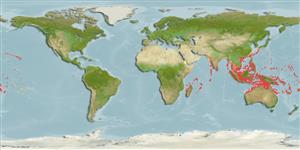Environment: milieu / climate zone / depth range / distribution range
Ecologia
marinhas; Água doce; estuarina associadas(os) a recifes; intervalo de profundidade 1 - 50 m (Ref. 57343), usually 20 - 50 m (Ref. 9685). Tropical; 34°N - 23°S, 50°E - 148°W (Ref. 57343)
Indo-Pacific: mainly around oceanic islands. Known from Mauritius, Seychelles, Kenya and many islands of the northern Indian Ocean; then from Indonesia north to the Ryukyu, Ogasawara and Yaeyama islands and east to the Hawaiian Islands, French Polynesia and Pitcairn. Has not been collected in Australia (Ref. 57343).
Tamanho / Peso / Idade
Maturity: Lm ? range ? - ? cm
Max length : 61.0 cm TL macho/indeterminado; (Ref. 4887); peso máx. publicado: 3.2 kg (Ref. 4699)
Espinhos dorsais (total) : 9; Raios dorsais (total) : 13; Espinhos anais: 3; Raios anais : 11. Body uniformly golden silver; occasionally with several faint dark stripes along longitudinal scale rows above and below lateral line. Pectoral filaments 6 with tip of uppermost filament reaching to or slightly beyond level of posterior tip of upper part of pectoral fin (Ref. 41110).
This schooling species occurs along sandy and rocky shorelines and over sandy lagoon bottoms, often in zones of turbulence (Ref. 9685). Benthopelagic (Ref. 58302). Often encountered in river mouths or brackish mangrove estuaries. Feeds mainly on crustaceans (shrimps and crabs), polychaete worms, other benthic invertebrates; also on teleosts (Ref. 9685). A lunar spawning rhythm occurs close to shore (Ref. 9685). Sexual maturity in males occurs at 12 to 15 cm (Ref. 9685). Subsequently undergoes sex reversal passing through a hermaphroditic stage, and become female between 18 and 24 cm (Ref. 9685). The potential of this species for aquaculture has been studied (Ref. 9685).
Ciclo de vida ou comportamento de acasalamento
Maturidade | Reprodução | Desova | Ovos | Fecundidade | Larvas
Motomura, H., 2004. Threadfins of the world (Family Polynemidae). An annotated and illustrated catalogue of polynemid species known to date. FAO Spec. Cat. Fish. Purp. Rome: FAO. 3:117 p. (Ref. 57343)
Status na Lista Vermelha da UICN (Ref. 130435: Version 2024-2)
Ameaça para os humanos
Harmless
Uso pelos humanos
Pescarias: espécies comerciais; Aquacultura: experimental; peixe esportivo: sim; Aquário: Espécies comerciais
Ferramentas
Relatórios especiais
Baixar XML
Fontes da internet
Estimates based on models
Preferred temperature (Ref.
123201): 24.1 - 29, mean 27.9 °C (based on 1038 cells).
Índice de diversidade filogenética (Ref.
82804): PD
50 = 0.5000 [Uniqueness, from 0.5 = low to 2.0 = high].
Bayesian length-weight: a=0.01820 (0.01035 - 0.03199), b=3.11 (2.96 - 3.26), in cm total length, based on LWR estimates for this species & (Sub)family-body (Ref.
93245).
Nível Trófico (Ref.
69278): 3.4 ±0.49 se; based on food items.
Resiliência (Ref.
120179): médio(a), tempo mínimo de duplicação da população 1,4 - 4,4 anos (Preliminary K or Fecundity.).
Fishing Vulnerability (Ref.
59153): Moderate vulnerability (44 of 100).
Nutrients (Ref.
124155): Calcium = 38.5 [16.0, 64.6] mg/100g; Iron = 0.484 [0.247, 0.933] mg/100g; Protein = 19.8 [18.0, 21.6] %; Omega3 = 0.111 [0.072, 0.175] g/100g; Selenium = 37.4 [19.5, 80.0] μg/100g; VitaminA = 31.6 [8.9, 109.8] μg/100g; Zinc = 1.02 [0.68, 1.55] mg/100g (wet weight);
